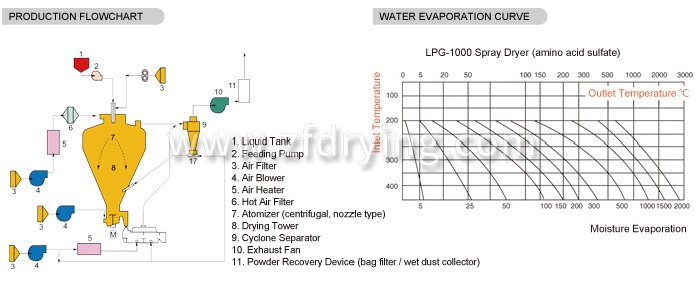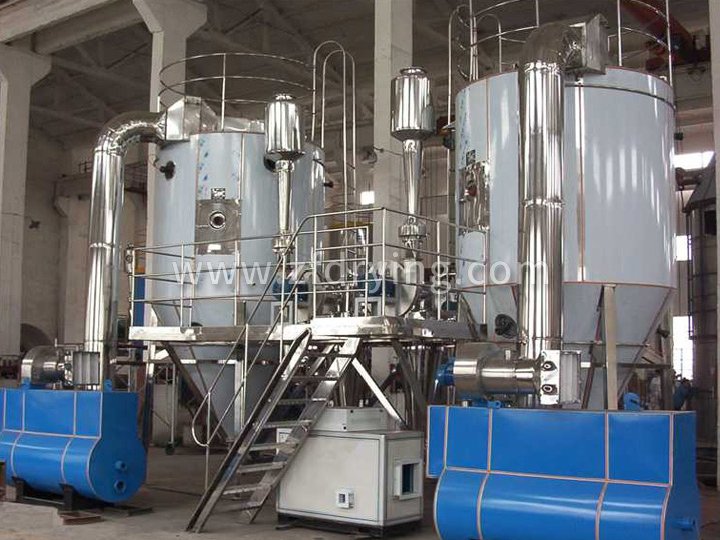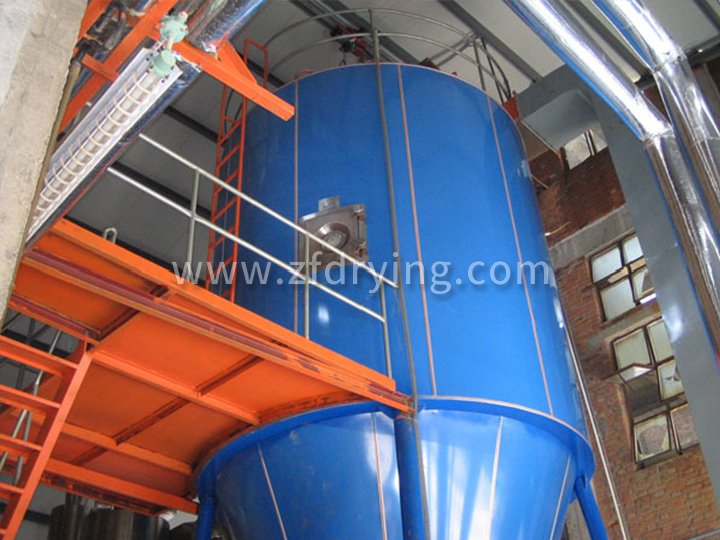Product Introduction
Spray drying is widely used in liquid forming and drying industries. It is especially suitable for generating powdery and granular solid products from solution, lotion, suspension and paste liquid raw materials. Therefore, when the particle size distribution, residual moisture content, bulk density and particle shape of the finished product must meet high standards, spray drying is a better process.
operational principle
The air is filtered and heated, entering the top air distributor of the dryer, and the hot air enters the drying chamber in a spiral and uniform manner. The feed liquid passes through the high-speed centrifugal atomizer on the top of the tower body, and (rotating) spray into extremely fine mist like liquid beads, which can be dried into finished products in a very short time in parallel with hot air. The finished product is continuously output from the bottom of the drying tower and the cyclone separator, and the exhaust gas is discharged by the fan.
Performance characteristics
The drying speed is fast, and the surface area of the material liquid greatly increases after atomization. In the hot air flow, 95% -98% of the water can be instantly evaporated, and the drying time is only a few seconds. It is particularly suitable for drying heat-sensitive materials.
The product has good uniformity, fluidity, and solubility, high purity, and good quality.
The production process is simplified and the operation and control are convenient. For liquids with a moisture content of 40-60% (up to 90% for special materials), they can be dried into powder products in one go, without the need for crushing and screening after drying, reducing production processes and improving product purity. The particle size, bulk density, and moisture of the product can be adjusted within a certain range by changing the operating conditions, making it easy to control and manage.
Adapt to materials
Chemical industry: sodium fluoride (potassium), alkaline dye pigments, dye intermediates, composite fertilizers, formaldehyde silicic acid, catalysts, sulfuric acid agents, amino acids, white carbon black, etc.
Plastic resin: AB, ABS lotion, urea formaldehyde resin, phenolic resin, sealant (urea) formaldehyde resin, polyethylene, PVC, etc.
Food industry: Rich fat milk powder, gluten, cocoa milk powder, milk substitute powder, blood hunting powder, egg white (yolk), etc.
Food and plants: oats, chicken juice, coffee, instant tea, spice meat, protein, soybean, peanut protein, hydrolysate, etc.
Carbohydrates: corn syrup, corn starch, glucose, pectin, maltose, potassium sorbate, etc.
Ceramics: alumina, ceramic tile materials, magnesium oxide, talc powder, etc.

Technical specifications
|
Model/Project/Parameters
|
5
|
25
|
50
|
150
|
200-2000
|
|
Inlet temperature
|
140-350 automatic control
|
|
Outlet temperature
|
80-90
|
|
Upper limit of
water evaporation (kg/h)
|
5
|
25
|
50
|
150
|
200-2000
|
|
Drive type of
centrifugal spray head
|
Compressed air transmission
|
mechanical drive
|
|
Upper limit of
rotational speed (r.p.m.)
|
25000
|
18000
|
18000
|
15000
|
8000-15000
|
|
Spray disc diameter (mm)
|
50
|
120
|
120
|
150
|
180-240
|
|
heat source
|
electricity
|
Steam+Electricity
|
Steam+electricity, fuel oil, gas, hot air stove
|
|
Upper limit of electric
heating power (kW)
|
9
|
36
|
72
|
99
|
|
|
Overall dimensions
(length × wide × Height (m)
|
1.8×0.93×2.2
|
3×2.7×4.26
|
3.5×3.5×4.8
|
5.5×4×7
|
Determine based on actual situation
|
|
Dry powder recovery (%)
|
≥95
|
Note: The amount of water evaporation is related to the characteristics of the material and the temperature of the thermal inlet and outlet. When the outlet temperature is 90oC, the water evaporation curve is shown in the above figure (for selection reference). As the product is constantly updated, relevant parameters are subject to change without prior notice.
Ordering Instructions
◎ Material name and physical properties: solid content (or water content), viscosity, surface tension, pH value.
◎ After drying, the powder capacity, allowable residual water content, particle size, and allowable upper temperature limit.
◎ Production and daily shift schedule.
◎ Energy supply: steam pressure supply, capacitance, and coal, oil, and gas supply.
◎ Control requirements: Do the inlet and outlet temperatures require automatic control.
◎ Powder collection requirements: Whether to install bag filters, environmental requirements for exhaust emissions.
◎ Other special requirements.
Technical specifications
|
size
|
A
|
B
|
C
|
D
|
E1
|
E2
|
F
|
G
|
H
|
I
|
|
LPG-25
|
1290
|
3410
|
4260
|
1800
|
1200
|
1200
|
1000
|
1700
|
1300
|
1550
|
|
LPG-50
|
1730
|
4245
|
5100
|
2133
|
1640
|
1640
|
1250
|
1750
|
1800
|
1600
|
|
LPG-100
|
2500
|
5300
|
6000
|
2560
|
2100
|
2100
|
1750
|
1930
|
2600
|
1780
|
|
LPG-150
|
2800
|
6000
|
7000
|
2860
|
2180
|
2180
|
1970
|
2080
|
3050
|
1960
|
|
LPG-200
|
2800
|
6600
|
7300
|
3200
|
2300
|
2300
|
2210
|
2250
|
3050
|
2100
|
|
LPG-300
|
2800
|
8000
|
8700
|
3700
|
2800
|
2800
|
2520
|
2400
|
3040
|
2250
|



